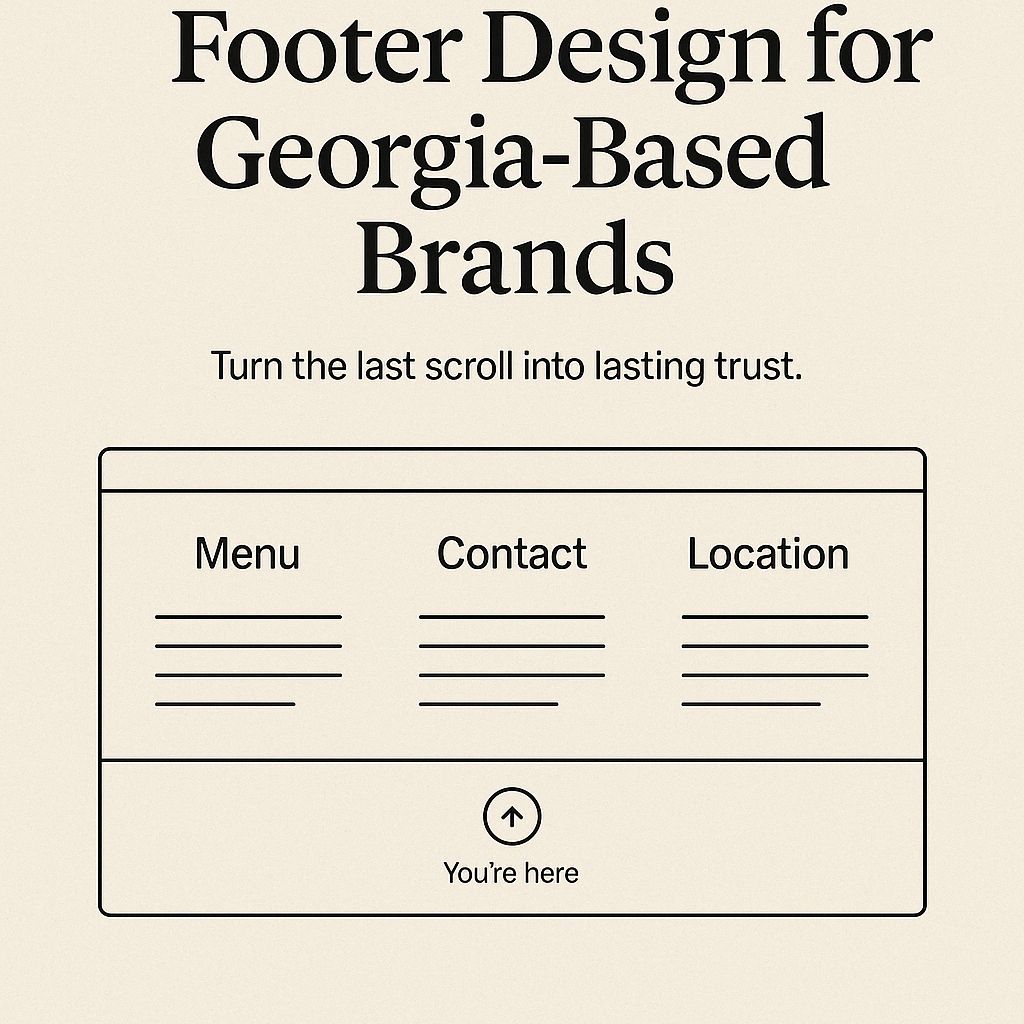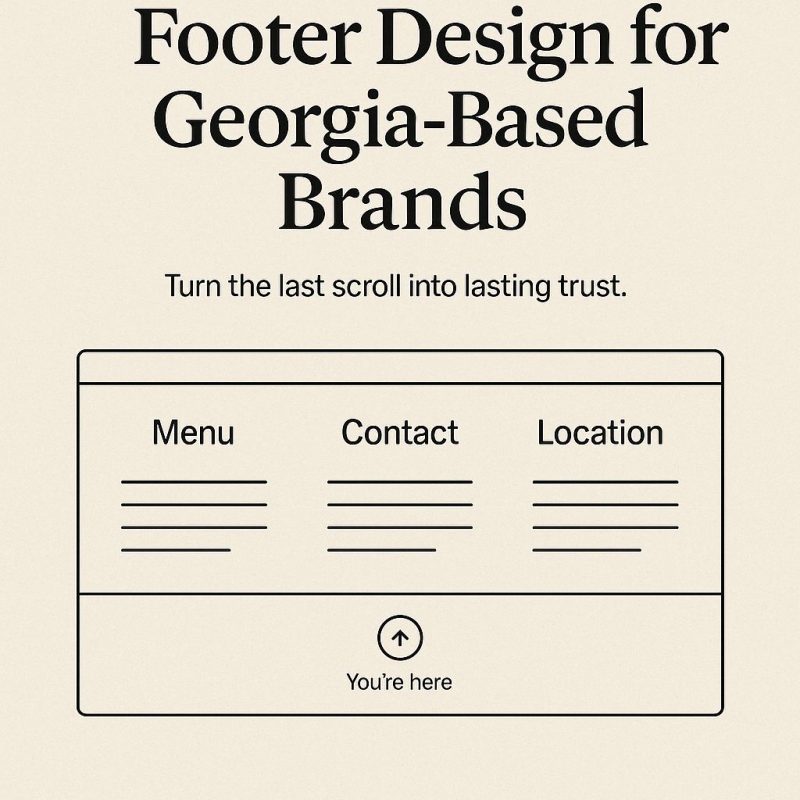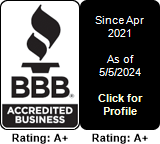The footer is the last thing users see on your site, but in Macon and across Georgia, it’s often the part they trust the most. That quiet space at the bottom of the page either confirms what they thought about your brand or shakes it. A sloppy, cluttered, or empty footer says you didn’t finish what you started. A clean, helpful, and intentional footer makes people feel like they’ve been guided well. It’s the difference between a handshake and a shrug. This cluster breaks down how local businesses can build footers that support navigation, build trust, improve local SEO, and create the right final impression before the user clicks away.
What Local Users Expect in a Website Footer in Macon
When someone in Macon scrolls to the bottom of your website, they’re usually looking for something specific. It could be a phone number, store hours, a way to send a message, or just confirmation that you’re a real business with a real presence nearby. They’re not looking to be impressed, they’re looking to be reassured. That means your footer can’t just be an afterthought full of tiny text and broken links. It needs to carry weight. Local users expect to see clear contact info in a format they can actually use—tap-to-call phone numbers, street addresses that link to Google Maps, office hours listed without jargon. They also expect to see standard links like About, Services, and Contact. Not clever phrases. Not fluffy branding. Just words that tell them what’s behind the curtain. And it’s not just about what you include—it’s where you place it. Your contact info shouldn’t be buried in the bottom-right corner in seven-point font. It should be easy to find, easy to read, and easy to trust. If your business serves specific areas around Macon, say so. Don’t just say “Serving Georgia.” Say “Proudly serving Macon, Warner Robins, and Gray.” That’s what builds local trust. Your footer is also a good place to let people know you’re open to hearing from them. A small message like “Got questions? We’re here to help” sets a tone that feels more human. And if someone is looking for legal details like a privacy policy or terms of service, they’ll expect to find it there too. Make sure those links are present and working. When a footer is done right, it feels like the final step in a conversation. When it’s done poorly, it feels like you stopped talking before the other person could respond. In Macon, where businesses still win or lose based on how well they show up for real people, your footer is part of your first impression. Even if it’s the last thing someone sees.
Strategic Link Placement in Macon Footers
Where you put your footer links matters just as much as what they say. In Macon, where digital literacy varies widely, users appreciate structure that feels familiar. That means placing navigation links in a clear horizontal or vertical group, typically near the left or center. Use one grouping for primary links like Home, Services, and About. Use a second set, visually separated, for supporting items like FAQ, Blog, or Resource Center. Avoid long link lists with small text that forces users to squint or scan endlessly. Group related links under short headers. If your business has multiple locations, consider adding a Locations section with city names or zip codes. This not only helps users but supports local SEO. Use anchor text that reflects user intent, not company language. “What We Offer” is less useful than “Our Landscaping Services in Macon.” And be mindful of mobile layouts. A four-column footer might look sharp on desktop but will turn into a clunky scroll on a phone. Stack links vertically and keep spacing generous. Also, avoid hiding links behind dropdowns or icons. The footer is not the place to get fancy. It’s where users expect clarity. When you guide someone naturally from the end of your content to the next step they should take, your footer becomes more than a layout element. It becomes part of your customer journey.
Legal and Contact Info Formatting for Georgia Businesses
It’s not enough to toss your phone number and address into a footer and hope users know what to do with it. In Georgia, where trust is earned through clarity, how you format your footer’s legal and contact information directly impacts user confidence. Start with a visible phone number in plain text, not buried in an image or hidden in a menu. Make sure it’s click-to-call on mobile. Add your physical address with a link to Google Maps. This gives users a sense of real presence and helps Google validate your location for search rankings. If you have multiple locations, list each clearly. Avoid confusing users with vague geographic language. Say “Serving Macon, Warner Robins, and Gray,” not “Available Throughout Central Georgia.” For legal links, use standard terms like Privacy Policy and Terms of Service. Don’t rename these into clever phrasing that hides their purpose. Place them in a quiet section of the footer, usually bottom-right or beneath the primary link group, and make sure they open in a new tab. Also include a small copyright line with your business name and the current year. It shows the site is maintained. If you collect user data—even if only through a contact form—you need a privacy policy. And if you use cookies or tracking, link to your cookie settings or include a brief explanation. Georgia users, especially older ones, may not demand this, but seeing it reassures them that your site is legitimate. Professional formatting doesn’t have to be flashy—it just has to be clear. In Macon, clarity equals credibility.
How Footers Influence Local SEO and User Retention
The footer isn’t just for humans. It’s for search engines too. Every internal link, every mention of your service area, and every reference to a physical location contributes to how well you rank for local queries. Google crawls your entire site, and the footer is one of the first places it checks for location signals and keyword relevance. That means your footer should include your city name in at least one sentence, like “Proudly serving Macon, GA and surrounding areas.” It also means that linking to core service pages—using varied, natural anchor text—helps reinforce site structure. Avoid repeating the same phrase across every footer. Instead, rotate through different but related terms: “View Our Services,” “Explore Lawn Care Options,” “Request a Free Quote.” These help build internal link depth without looking like spam. Footers also support user retention. Someone who scrolls to the end of your homepage or a blog post is looking for a next step. If you give them easy access to key links and useful information, they’ll stay longer, view more pages, and are more likely to convert. A footer with no links or only legal text is a dead end. One with helpful resources, local signals, and a friendly closing message like “Let’s build something together” keeps the experience warm and connected. And in Georgia, where service and relationships still drive referrals, a footer that supports both user and crawler builds better business over time.
Design Aesthetics That Elevate Footer Function in Macon
Footers don’t have to be boring. They just have to feel like they belong. In Macon, where customers expect websites to be both modern and grounded, the best footers use clean lines, legible typography, and structured spacing to create a sense of calm authority. Keep your background dark or muted—navy, charcoal, deep green—with white or soft gray text for contrast. Use one or two font weights, never more. Divide sections with subtle lines or generous padding, not with cluttered boxes. Consider including your logo in the footer if space allows, but keep it small. Social icons should be visible but not dominant. Position them away from core links and make sure they open in new tabs. On mobile, footers should collapse sections in a tap-friendly way. Accordion menus can work, but only if they’re clearly labeled and tested across devices. Decorative icons or patterns are fine, as long as they don’t interfere with function. A footer should not demand attention. It should hold the page together with quiet structure. Users often make their final judgment at the bottom of a page. If the footer looks unfinished or messy, that judgment turns against you. If it looks thoughtful and easy to use, they leave with confidence. Design in Macon is still about tone. Make your footer feel like part of the handshake, not just the goodbye.
Want a Footer That Leaves a Better Last Impression?
We help Georgia businesses design footers that feel finished, functional, and built to guide. If yours is just a block of clutter or a missed opportunity, visit conversion focused footer web design in Macon and let’s make that last scroll count.



